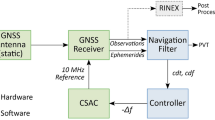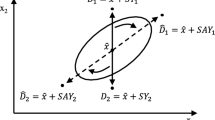Abstract
Binary offset carrier (BOC) modulation technology is widely used in newly developed and modernized global navigation satellite systems. BOC signal offers superior performance over conventional binary phase-shift keying signal due to its sharp auto-correlation function. However, the main drawback of BOC signal tracking is the ambiguity problem caused by the presence of multiple side-peaks in the auto-correlation function. We derive a new analytical model to solve the ambiguity issue. Based on the derived analytical model, a code tracking algorithm that completely removes all ambiguities is introduced. Theoretical analysis and simulation show that the proposed technique significantly improves the multipath mitigation performance and code tracking accuracy in thermal noise over those of existing side-peaks-cancellation techniques.
















Similar content being viewed by others
References
Betz JW (2001) Binary offset carrier modulations for radionavigation. Navig J Inst Navig 48(4):227–246. https://doi.org/10.1002/j.2161-4296.2001.tb00247.x
Fine P, Wilson W (1999) Tracking algorithm for GPS offset carrier signals. In: Proceedings of the ION NTM 1999, Institute of Navigation, San Diego, California, USA, January 25–27, pp 671–676
Hodgart MS, Blunt PD (2007) Dual estimate receiver of binary offset carrier modulated signals for global navigation satellite systems. Electron Lett 43(16):1241–1241. https://doi.org/10.1049/el:20071101
Irsgler M (2005) Criteria for GNSS multipath performance assessment. In: Proceedings of the ION GNSS 2005, Institute of Navigation, Long Beach, California, USA, September 13–16, pp 2166–2177
Julien O, MacAbiau C, Cannon ME, Lachapelle G (2007) ASPeCT: unambiguous sine-BOC(n, n) acquisition/tracking technique for navigation applications. IEEE Trans Aerosp Electron Syst 43(1):150–162. https://doi.org/10.1109/TAES.2007.357123
Kao T-L, Juang J-C (2012) Weighted discriminators for GNSS BOC signal tracking. GPS Solut 16(3):339–351. https://doi.org/10.1007/s10291-011-0235-7
Kaplan ED, Hegarty C (2006) Understanding GPS: principles and applications, 2nd edn. Artech House, Boston
Lohan ES, Burian A, Renfors M (2010) Low-complexity unambiguous acquisition methods for BOC-modulated CDMA signals. Int J Satell Comm Netw 26(6):503–522. https://doi.org/10.1002/sat.922
Lohan ES, Diego DAD, Lopez-Salcedo JA, Seco-Granados G, Boto P, Fernandes P (2017) Unambiguous techniques modernized GNSS signals: surveying the solutions. IEEE Signal Process Mag 34(5):38–52. https://doi.org/10.1109/MSP.2017.2711778
Martin N, Leblond V, Guillotel G, Heiries V (2003) BOC(x, y) signal acquisition techniques and performances. In: Proceedings of the ION GPS/GNSS 2003, Institute of Navigation, Portland, Oregon, USA, September 9–12, pp 188–198
Pany T, Irsigler M, Eissfeller B (2005) S-curve shaping: a new method for optimum discriminator based code multipath mitigation. In: Proceedings of the ION GNSS 2005, Institute of Navigation, Long Beach, California, USA, September 13–16, pp 2139–2154
Paonni M, Avila-Rodriguez JA, Pany T, Hein GW, Eissfeller B (2008) Looking for an optimum S-curve shaping of the different MBOC implementations. Navig J Inst Navig 55(4):255–266. https://doi.org/10.1002/j.2161-4296.2008.tb00435.x
Qi J, Chen J, Li Z, Zhang D (2012) Unambiguous BOC modulated signals synchronization technique. IEEE Commun Lett 16(7):986–989. https://doi.org/10.1109/LCOMM.2012.050112.112521
Shen F, Xu GH, Cheong JW, Feng HY (2015) Unambiguous acquisition and tracking technique for general BOC signals. Radioengineering 24(3):840–849. https://doi.org/10.13164/re.2015.0840
Yan T, Wei J, Tang Z, Qu B, Zhou Z (2015a) Unambiguous acquisition/tracking technique for high-order sine-phased binary offset carrier modulated signal. Wirel Pers Commun 84(4):2835–2857. https://doi.org/10.1007/s11277-015-2769-4
Yan T, Wei J, Tang Z, Qu B, Zhou Z (2015b) Unambiguous combined correlation functions for sine-BOC signal tracking. GPS Solut 19(4):623–638. https://doi.org/10.1007/s10291-014-0420-6
Yao Z, Lu M, Zhenming F (2009) Unambiguous technique for multiplexed binary offset carrier modulated signals tracking. IEEE Signal Process Lett 16(7):608–611. https://doi.org/10.1109/LSP.2009.2020462
Yao Z, Cui X, Lu M, Feng Z, Yang J (2010a) Pseudo-correlation-function-based unambiguous tracking technique for sine-BOC signals. IEEE Trans Aerosp Electron Syst 46(4):1782–1796. https://doi.org/10.1109/TAES.2010.5595594
Yao Z, Lu M, Inst N (2011) Side-peaks cancellation analytic design framework with applications in BOC signals unambiguous processing. In: Proceedings of the ION ITM 2011, Institute of Navigation, San Diego, California, USA, January 24–26, pp 775–785
Yin B, Wang G, Qi Y (2017) Unambiguous sine-phased binary offset carrier modulated signal tracking technique. Optik Int J Light Electron Opt 132:284–290. https://doi.org/10.1016/j.ijleo.2016.12.055
Acknowledgements
This work was supported by the National Natural Science Foundation of China (Grant no. 61401171).
Author information
Authors and Affiliations
Corresponding author
Additional information
Publisher’s Note
Springer Nature remains neutral with regard to jurisdictional claims in published maps and institutional affiliations.
Appendices
Appendix 1: Derivation of the code tracking error variance
Let
then
where
where \({n_1}=\sqrt {2C} {\hat {R}_{{\text{BOC}},2}}\left( {\frac{{\Delta d}}{2}} \right)(n_{1}^{{{\text{IE}}}} - n_{1}^{{{\text{IL}}}})\), \({n_2}=\sqrt {2C} {\hat {R}_{{\text{BOC}},1}}\left( {\frac{{\Delta d}}{2}} \right)(n_{2}^{{{\text{IE}}}} - n_{2}^{{{\text{IL}}}})\), \({n_3}=n_{2}^{{{\text{IE}}}}n_{2}^{{{\text{IE}}}} - n_{2}^{{{\text{IL}}}}n_{2}^{{{\text{IL}}}}\), and \({n_4}=n_{2}^{{{\text{QE}}}}n_{2}^{{{\text{QE}}}} - n_{2}^{{{\text{QL}}}}n_{2}^{{{\text{QL}}}}\).
According to (29), we have
Then, we have
The code tracking error variance in thermal noise is given by (Kao and Juang 2012)
By substituting (32) and (38) into (39), we have
Appendix 2: Example of how a quasi-unambiguous algorithm falsely locks onto side-peak
We present Fig. 17 to illustrate the false lock risk for a quasi-unambiguous algorithm. The figure shows the code tracking error versus time when an acquisition bias of \(- 0.875{T_{\text{c}}}\) is introduced for a BOC(10, 5) signal. The \(C/{N_0}\) is 40 dB Hz, other simulation parameters, e.g., front-end bandwidth and correlator spacing, are set to be the same as those of the BOC(10, 5) code tracking error simulation.
As can be seen, Yan’s method steadily locks at \(- 0.875~{T_{\text{c}}}\) due to the false lock points. In this case, the receiver outputs problematic pseudorange measurements, which eventually result in unacceptable positioning bias. The proposed algorithm cannot lock at the false lock point, which is as expected since it does not have any false lock points on its discriminator output. Once the lock detector of the GNSS receiver detects a loss lock, it will start a re-acquisition process; thus, the proposed BUT–EAS avoids tracking bias.
To further analyze the above-mentioned process, we introduce a typical lose lock detection criterion for the GNSS receiver, which is given by Kaplan and Hegarty (2006):
where \({\sigma _{{\text{tDLL}}}}\) is the STD of thermal noise jitter in chips; \({R_{\text{e}}}\) is the dynamic error in chips; \(\Delta d\) is double-sided correlator spacing, which is \(0.1{T_{\text{c}}}\) for BOC(10, 5). In this simulation we did not introduce dynamics; thus, \({R_{\text{e}}}=0\). As shown in (41), if the STD of thermal noise jitter exceeds the loss lock threshold of \(\frac{d}{6}=0.016667{T_{\text{c}}}\), the receiver can detect the loss lock status. From Fig. 17 we can see that the STD of thermal noise jitter for Yan’s method is far smaller than the lock detector threshold. Thus, the receiver will falsely verify that it is tracking on the main-peak, which will result in unacceptable positioning bias. The STD of code tracking error for BUT–EAS exceeds the lock detector threshold. Thus, the receiver detects the loss lock status at the beginning and return to re-acquisition cycle. In this way, the receiver avoids wrong positioning solutions.
To conclude, relative to ambiguous algorithms, such as NELP, quasi-unambiguous algorithms result in significant improvements in terms of ambiguity suppression performance. However, the false lock risk still exists when using a quasi-unambiguous algorithm such as Yan’s method. By contrast, the proposed BUT–EAS is an unambiguous algorithm that suppresses all side-peaks to avoid false locks.
Rights and permissions
About this article
Cite this article
Wang, B., Li, T., Wei, J. et al. A new unambiguous tracking algorithm for sine-BOC(m, n) signals. GPS Solut 23, 58 (2019). https://doi.org/10.1007/s10291-019-0849-8
Received:
Accepted:
Published:
DOI: https://doi.org/10.1007/s10291-019-0849-8





